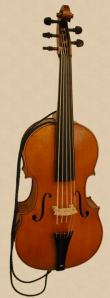Tags
Anna Magdalena Bach, Boulder Bach Festival, Cöthen, cello, da gamba, da spalla, dance, First Congregational Church, La Petite Bande, Ryo Terakado, Sergey Malov, Sigiswald Kuijken, Sonatas and Partitas for Violin, suite, Suite in D Major, Suite in G Major, Suites for Unaccompanied Violoncello, viola, violoncello, violoncello da spalla, Zachary Carrettin
Bach’s six Suites for solo violoncello (BWV 1007-12) are among the most frequently performed compositions written for an unaccompanied stringed instrument. Each suite consists of six dance movements, and the entire collection is carefully conceived as a cycle as opposed to an arbitrary series of pieces.

Violoncello da spalla by Dmitry Badiarov
Most likely composed during Bach’s Cöthen period, the lack of an autographed manuscript results in uncertainty as to whether the suites were composed before or after the 1720 Sonatas and Partitas for solo violin (BWV 1001-6), and the vagueness of the early use of the term “violoncello” (“small large viol”) does not suggest whether the pieces were to be played on an instrument held da gamba (between the legs) or da spalla (on the shoulder).
Bach’s second wife, Anna Magdalena, prepared a copy of the suites and indicated that the sixth was to be performed on an instrument with a fifth string tuned a perfect fifth above the top string of our modern cello. Cellists wishing to play this Suite in D Major (BWV 1012) on a four-string cello must employ high positions to execute many of the notes, while performers of period instruments can choose either a five-string Baroque cello held da gamba or a da spalla form of the instrument.
Sigiswald Kuijken has recorded all six suites on the violoncello da spalla, as has Ryo Terakado, also of La Petite Bande. Sergey Malov, violinist, violist and relative newcomer to the violoncello da spalla, offers an online performance of the gigue from the Suite in G Major (BWV 1007).
Boulder Bach Festival concertmaster Zachary Carrettin will perform the entire Suite in G Major on viola at a Benefit Concert at 6:30pm on 24 May 2012 at First Congregational Church in Boulder.
